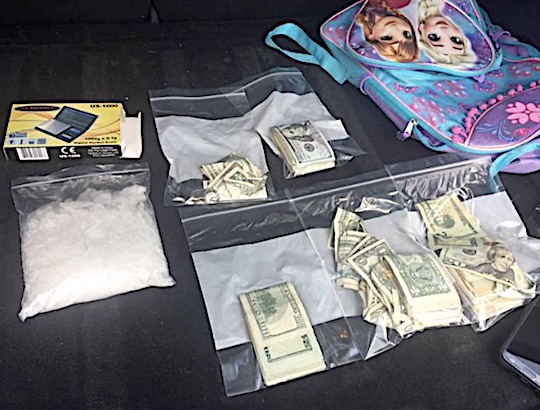‘Crystal meth by the pound.’ Drug’s rise in Kentucky leads to arrests, abuse…

PRESTONSBURG – Officers doing drug investigations in Floyd County usually go out to make undercover buys three nights a week.
There was a time when they would have bought mostly pain pills, and more recently Suboxone, a drug used in addiction treatment but also sold illegally, was the big drug on the street.
Now, however, officers usually spend most of their money on methamphetamine, said Sheriff John Hunt.
“Meth just jumped up and became the most dominant drug problem,” Hunt said. “Ninety-nine percent of what we’re doing is meth.”
Floyd County isn’t the only place where problems with meth have gone up significantly in the last couple of years, according to police.
Arrests for first-degree trafficking in meth went up 173 percent statewide between 2013 and 2017, said Capt. Derek Grant, commander of the Kentucky State Police Drug Enforcement Special Investigations office covering the west end of the state.
“Meth is definitely pretty rampant right now,” Grant said.
The rise in abuse is showing up in the state’s grim overdose death count.
Autopsies detected meth in 29 percent of the record 1,565 overdose deaths counted in Kentucky last year, according to a report from the Kentucky Office of Drug Control Policy.
That was a 57 percent increase, even as deaths involving pain pills declined.
The increase also has had an impact on treatment programs.
Addiction Recovery Care LLC, which operates residential and outpatient treatment centers in Kentucky for alcohol and drug abuse, has made changes to deal with the rise of meth abuse, including opening a unit to stabilize women in crisis, said Tim Robinson, the chief executive officer.
There have been more people seeking treatment for meth abuse every quarter this year, Robinson said.
Meth is powerful. People entering treatment have more symptoms, including hallucinations, which makes it more difficult to treat people addicted to meth, and it can take 60 days or more to stabilize some people, Robinson said.
Another challenge is that people who have been using meth are more likely to leave treatment against medical advice than people being treated for addiction to painkillers called opioids, Robinson said.
“We’ve never seen meth at this level,” he said.
The meth that has become prevalent in Kentucky and the nation is called crystal meth.
Drug organizations using labs in Mexico make most of what is available in the U.S. and smuggle it across the Southwest border, according to the U.S. Drug Enforcement Administration.
Meth seizures along the U.S. border with Mexico went up 255 percent between 2012 and 2017, the agency said in its 2018 national drug threat assessment.
But smugglers still got a lot of meth into the country.
Five or 10 years ago, it was rare for police in Kentucky to seize even an ounce of crystal meth, said Tommy Loving, head of the Bowling Green – Warren County Drug Task Force.
“Now we get crystal meth by the pound,” Loving said.
Traffickers get meth into the U.S. a number of ways, including in personal vehicles and shipments of commercial goods.
In December 2017, for instance, agents stopped a Lincoln Navigator in Nashville that had 110 pounds of meth paste hidden in special compartments welded inside the wheel rims, according to the DEA.
It also has become more common for smugglers to bring in meth dissolved in liquid and then convert it back to crystal meth once in the U.S., according to the DEA.
Mexican authorities placed controls on the chemicals needed to make the drug, but the cartels that control manufacturing and distribution have found alternatives, with many of the chemicals traced to sources in China, according to DEA.
Abuse of the drug has gone up in Kentucky because meth is powerful, plentiful and cheap.
Mexican drug organizations have pushed to find additional markets for the drug, and the price for a gram of meth went down 13.6 percent between 2012 and March 2017 as the purity went up, according to the DEA report.
One consequence of the rise of potent, imported crystal meth has been a sharp drop in the number of small, improvised labs in Kentucky and other states.
It was once common for people to produce homemade meth by mixing substances that included drain cleaner with pills containing an over-the-counter decongestant called pseudoephedrine to create a chemical reaction.
People used containers such as plastic soft drink bottles to mix the chemicals, so the process was called “one-step” or “shake and bake.”
The labs caused a range of problems beyond drug abuse, leaving behind waste considered toxic and driving up cleanup costs for contaminated apartments, hotel rooms and dump sites.
The labs create noxious fumes and can explode, endangering cookers, children and neighbors. Jackie Steele, commonwealth’s attorney for Laurel and Knox counties, described the process as “cooking with a bomb.”
There were many cases in Kentucky of the labs blowing up, burning and injuring people.
In one case in Danville in 2013, an explosion that injured two people and left a gaping hole in the side of an apartment building might have been caused by a meth lab, authorities said.
And in one disturbing case, a 20-month-old in Wayne County, Kayden Daniels, also known as Kayden Branham, drank drain cleaner from a cup that had been left out after people used the chemical in making meth at the small mobile home where he and his parents were staying.
The drain cleaner contained sulfuric acid. Kayden died of severe internal injuries an hour after drinking it in May 2009.
His mother pleaded guilty in connection with his death in a closed juvenile-court proceeding. His father, Brian Daniels, was jailed nearly four years waiting trial, but a jury ultimately acquitted him of a murder charge.
State and federal lawmakers tried to drive down homemade meth production with measures that included tracking of pseudoephedrine sales and limits on the amount of the medicine people can buy.
The difficulty and cost of rounding up ingredients for homemade meth, the work to produce it, and the relative higher potency and lower price of crystal meth have combined to nearly put an end to one-step labs.
“I don’t think you could make it as cheap as you could buy it,” said Van Ingram, head of the Kentucky Office of Drug Control Policy.
The number of lab incidents in the state peaked at 1,233 in 2011, then plummeted to just 99 in 2017 and only 35 so far this year, according to statistics maintained by state police.
“The old-fashioned shake and bake, that’s just a thing of the past,” said Laurel County Sheriff John Root.
There were only four meth-lab incidents in Laurel County last year, down from a state-high 116 in 2011, according to state police.
The rise of crystal meth has caused other problems, however. Authorities said crystal meth can make users paranoid, unpredictable and violent.
Hunt, the Floyd County sheriff, said meth abuse has meant more inmates, and so more cost, at the county jail, and his officers have been doing more “mental transports” of people who need treatment because of problems associated with meth.
Floyd County Commonwealth’s Attorney Brent Turner said that in one local case, a man suspected of being on meth was accused of slashing his girlfriend’s face with a knife.
The woman told police the man had used drugs and “was talking out of his head” before he got mad and slashed her. It took 55 stitches to close the wounds, according to a citation.
In another case, a man believed to have been using crystal meth shot a police officer in the chest. The officer survived and others arrested the man.
“We do see people doing irrational type acts when they are on it,” Turner said.
People seeking help with substance abuse in Kentucky can call 1-833-8KY-HELP (1-833-859-4357) for information on treatment and resources or visit www.findhelpnowky.org.
By Bill Estep
Lexington Herald-Leader













![Foothills-Bundle] Foothills-Bundle](https://thelevisalazer.com/wp-content/uploads/2020/05/Foothills-Bundle-422x74.jpg)






Most people who get Suboxine just take it out and sell it there should be a way to make them come in and take the pill right there